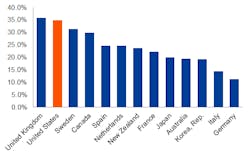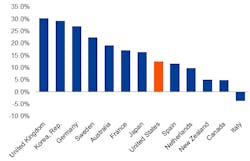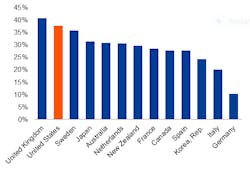Why is America's Manufacturing Job Loss Greater than Other Industrialized Countries?
The rapid decline of U.S. manufacturing employment demonstrate the severity of the challenges faced by America’s manufacturing industries. In July 2014, ITIF’s Stephen Ezell testified before the Senate Finance Committee regarding the importance of manufacturing to America’s economy and the role that U.S. trade and technology policy plays in supporting American manufacturing.
As part of his testimony, Ezell pointed out that since 2000 America’s manufacturing sector has been in a steep decline, with job losses outpacing those in many peer countries.
A counter report suggesting that there is not a clear cause for alarm regarding employment losses in the American manufacturing sector was produced by Marc Levinson, a Section Research Manager with the Congressional Research Service.
However, Levinson’s account does not fully present all of the facts and only succeeds in further muddying this important policy debate.
One critique Levinson makes is charging Ezell with bias in selecting base years, which can have a sizable impact on analytical results. Levinson presents data using the years 1991 to 2000 and then the years from 2001 to 2010. However, this assessment actually makes the same error he attributes to Ezell’s work by not including job movement data from 2000 to 2001, when the American manufacturing sector lost over 1.2 million jobs, one of the single worst years for U.S. manufacturing job loss over the past two decades. Levinson then presents data from 1991 to 2012, ignoring the fact that most job loss in this period occurred since 2000, in an attempt to smooth the data and mute the alarm bells.
But chief among the flaws in Levinson’s analysis is the failure to incorporate changing labor force size into calculations of labor decline. From 1997 to 2012, the U.S. population of working-age citizens increased from 203 million to 243 million. Even if total, full-time manufacturing jobs had remained constant over this period (instead of shedding close to 5 million jobs), manufacturing jobs would represent a smaller portion of the U.S. economy. In other words, America’s manufacturing job loss is even worse when the total growth of America’s workforce over this period is considered.
This trend is magnified when using data from the Bureau of Labor Statistics (BLS) that measures only full-time employment in manufacturing data—a dataset with a narrower, more focused, definition of manufacturing jobs in the United States. While BLS data is not as readily comparable with other nations as OECD data is, it does show that between 2001 and 2010, America’s economy shed 33% of its jobs (approximately 5.8 million), a 42% decline when controlling for workforce increases. In contrast, Germany lost just 11% of its manufacturing jobs, when controlling for increases in working-age population over this period, as Figure 1 shows.
Figure 1: Manufacturing Job Loss from 2000 to 2009, as a percentage of working-age population. Source: International Comparisons of Annual Labor Force Statistics, 1970-2012
US Vs. Other Industrialized Countries
This bears a sharp contrast to just a few years before, when the United States saw five straight years of manufacturing job growth from 1994 to 1998. In fact, the United States fared better than most peer nations from 1990 to 1999 in terms of manufacturing job losses as a percentage of working-age population, bettering a number of competitors, including Germany, Japan, Korea, and the United Kingdom over this period, as Figure 2 shows.
Figure 2: Manufacturing Job Loss from 1990 to 1999, as a percentage of working age population. Source: International Comparisons of Annual Labor Force Statistics, 1970-2012. (This chart uses 1991-1999 data for Germany.)
So what, then, explains the sudden relative steep increase in American manufacturing job losses during the 2000s? Does this simply reflect the vicissitudes of global financial markets? No. Rather, as ITIF writes in Innovation Economics: The Race for Global Advantage, what really happened after 2000 was the rise in use of innovation mercantilist practices by many of our global competitors that were specifically designed to boost these countries’ domestic production at the expense of American manufacturers.
These trends were only exacerbated following China’s entry into the World Trade Organization in 2001, as the Chinese government created a specific innovation mercantilist policy framework, which has included currency and standards manipulation, local content requirements, and the forced transfer of intellectual property and technology as a condition of market access. This in turn ignited a subsequent global contagion effect, leading numerous other nations, from India to Brazil to Russia, to adopt similar innovation mercantilist policies which have further harmed the interests of American manufacturing.
At the same time, other competitors, such as Germany, have generally played by the rules of the global trade system yet have significantly boosted their efforts to implement science, technology, innovation, and industry-university collaboration policies throughout the 2000s, steadily bolstering the competitiveness of their manufacturing sectors.
For example, Germany, which The Economist lamented as the sick man of Europe in a 1999 article (in part a result of taking on struggling East German state economies post-reunification) recognized its manufacturing underperformance in the 1990s (as reflected in Figure 2) and set about enacting a range of comprehensive economic reforms to increase the competitiveness of Germany’s economy throughout the 2000s, including making its tax code more competitive, articulating The High-Tech Strategy for Germany, increasing investment in apprenticeship programs, increasing investment in its Fraunhofer network focusing on investments in industrially relevant applied R&D, and during the Great Recession introducing the Kurzarbeit (short-time work) program. Kurzarbeit helped German companies respond to the drop in global demand engendered by the Great Recession not by firing workers outright (as was too often the case in the United States), but by cutting their work to part-time and using the remaining time to retrain/reskill them (through a program collaboratively funded by German industry, labor unions, and state and federal governments) and so when global demand recovered German firms were fully staffed, and with a workforce reskilled to leverage the technologies and manufacturing processes of the future.
And of course, Germany is not alone; many more of America’s competitors—including Japan, Korea, Holland, Taiwan, and even China—worked feverishly throughout the 2000s to bolster their science, technology, and innovation ecosystems that underpin the competitiveness and innovation potential of their private sector enterprises.
Yet all this at a time while America largely dithered and allowed the policy environment supporting the competitiveness of its manufacturing industries to wane. Indeed, as ITIF writes in Fifty Ways to Leave Your Competitiveness Woes Behind: A National Traded Sector Competitiveness Strategy, through a combination of policy inaction and inattention, America’s investments in R&D languished over the past decade and a half, as its tax code grew ever more globally uncompetitive, its industrial commons eroded, and its talent base weakened.
This is one key reason why, at the end of the last decade, German employment in the manufacturing sector, at 19.8%, almost doubled that of the United States, at 10.3%. Put simply, American manufacturing job loss over the past decade has been no joke, and it has been steeper than that of many peer countries.
Figure 3 widens the analysis of manufacturing job loss as a percentage of working-age population out to the years 1997 to 2012, again using Bureau of Labor Statistics data. It shows that, over this period, America’s decline in manufacturing jobs, as a percentage of working-age population, reached 38%, while Germany’s was just 10%.
Public Policy
Again, that’s not an accident; it’s explained in large part because Germany implemented a serious and robust set of policies to enhance its manufacturing competitiveness. The United States and United Kingdom, more apt to let the “invisible hand” of the market solely determine outcomes, fared considerably worse. Even after adjusting start and end years to include periods of U.S. manufacturing job gains in the late 1990s and during the recovery from the Great Recession, the United States outpaces all other peer countries besides the United Kingdom in terms of manufacturing job losses since 1997.
In short, Germany saw the trend depicted in Figure 2 and implemented serious policy reforms to do something about it. The question is whether America will recognize the trend depicted in Figure 3 and decide to implement reforms improving both the business and public policy environment supporting American manufacturers and manufacturing jobs.
Figure 3: Manufacturing Job Loss from 1997 to 2012, as a percentage of working age population. Source: International Comparisons of Annual Labor Force Statistics, 1970-2012
Finally, while some argue these trends can be explained by increased productivity from America’s manufacturing sectors, the reality is that this explanation only partially explains America’s rapid manufacturing jobs decline. It’s very true that fewer workers are needed now to make products. Manufacturing jobs in the United States are no longer dominated by workers placed along assembly lines and they increasingly demand high-tech skills and advanced degrees from a myriad of fields.
Yet this trend is true in all advanced economies being compared to the United States, and was even true in the 1990s when America held its ground in manufacturing employment. As explained in Worse than the Great Depression: What Experts are Missing about American Manufacturing Decline, a full third of manufacturing job loss is completely independent from improvements in productivity.
Moreover, decline in jobs has been associated with flat levels of capital investment and drastic increases in America’s trade deficit, both of which point to declining manufacturing strength rather than productivity increases. While all advanced economies have shed jobs due to increased productivity, the rapid decline of manufacturing jobs in the United States since 2000 is indicative of a more distinctive and deleterious trend, one that has been amplified by the lack of a serious manufacturing competitiveness policy in the United States.







